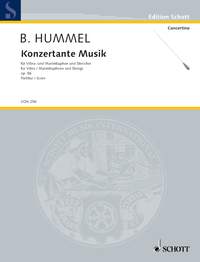Concertante Music for Vibraphone and Marimbaphone (1 Player) and Strings, Op. 86 (1986)

I. Moderato
II.
Allegro ![]() beginning
beginning
III. Recitative - Chorale - Finale
First
performance: November 1, 1986, Darmstadt, Orangerie
Mark Christopher Lutz
/ Kammerorchester Merck / Zdenek Simane
Duration: 25 Minutes
Publisher: Schott MusicScore: Con 258 / ISMN: M-001-15304-1
Parts: Con 258-50 / ISMN: M-001-15303-4
Piano reduction: ED 20468 / ISMN: M-001-15390-4
| I. Score | II. Score | III. Piano reduction | Percussion legend |
Foreword (Schott Music)
The
Concertante Music for Vibraphone, Marimbaphone and Strings Op.
86, a commission by the chamber orchestra Merck on the occasion of its 20th anniversary,
was composed between July and September 1986.
A remarkable novelty of the work
is the special positioning of the vibraphone and marimbaphone which allows the
soloist to operate both instruments in a similar manner to an organist playing
on different manuals. This aspect is naturally incorporated into substantial passages
of the composition with virtuoso transitions from one instrument to the other
and the tonal amalgamation of both instruments.
The three-movement work juxtaposes
the solo part with a 13-part string ensemble, also providing opportunities for
contrast and amalgamation.
In the first movement Moderate, rhapsodic
formulations alternate with lyrical-ariosa sections and light and dark colours
are contrasted within a small space. Three episodes with four-part marimba tremoli
and two cadenza-like transition passages function as structural divisions.
The
second movement, Allegro, is characterised by a pulsating, relentless
rhythmic motion in confrontation with a graceful Tempo di valse. Both types
of movement are also juxtaposed in the brief solo cadenza. The rondo-like alternation
with ever new twists and turns dies away suddenly in extreme pianissimo.
The
third movement Recitative - Chorale - Finale initially provides
the soloist with the opportunity for "free speech". Chorale-like sections
(marimba) with episodes (vibraphone) take on a tranquil character against the
high pedal points in the violins. The directly ensuing finale (Presto)
provides the soloist with multiple opportunities for virtuoso development. The
intermediate somewhat grotesque march episode has a relaxing effect. All elements
of this movement are incorporated into the extensive cadenza. The Presto
continues and new variations are added; the musical impetus is variously harnessed
by fermatas and reminiscences. An ironical conclusion is attached to the culminating
bars of the coda.
I hope that this work conveys something of the high
spirits which I experienced during the composition of my opus 86.
Bertold Hummel